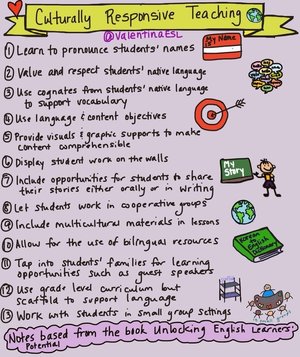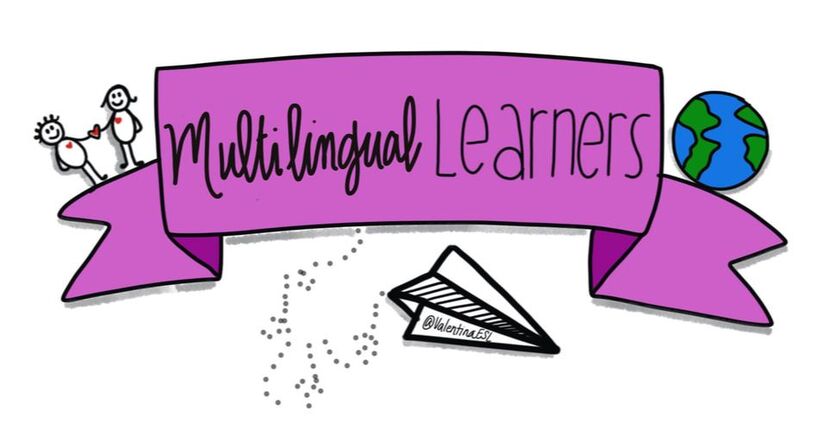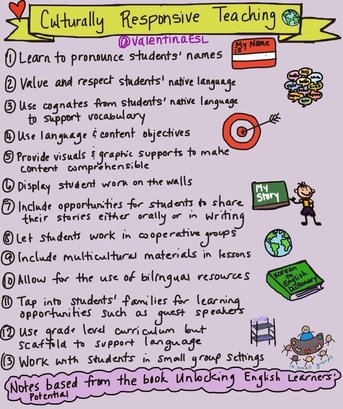|
Let's back up a little and break it down. What is culture? Culture has many meanings and it depends on who you ask or which source you use. If you review most definitions, they all have somethings in common. Zion and Kozleski describe culture as the "shared beliefs, views, values, customs, behaviors and artifacts that the members of society use to interact with their world and with one another (as cited in Fenner & Snyder, 2017). From this definition, I know we can gather that everyone has a culture. We all have beliefs and views. We all carry values and customs. We all have certain behaviors and artifacts related to our own society that we use to interact with the world and with others. This leads me to the conclusion that being culturally responsive is not only going to benefit my English Learners, it will benefit every child in my classroom.  In their book, Unlocking English Learners' Potential, Fenner and Snyder share the 3 levels of culture. 1. Surface: What we can observe easily. These are the the obvious things. For example, food and clothing. 2. Shallow: These are a little more difficult to see. They are related to communication and behavior. For example, non verbal communication and beliefs about personal space. 3. Deep: These are the unspoken knowledge. For example, beliefs about cooperation and collaboration. So why should we be culturally responsive when we teach? Culture impacts not only how students learn but also how we teach. When there is a mismatch in how we teach and students' cultural beliefs about learning, then there may be frustration on both sides. Teacher: Why doesn't my ELL participate? Student: Why does my teacher put us in groups to talk? Let's say we as teachers value collaboration and open communication, but students from various cultures are not accustomed to classrooms where students work in collaborative groups. This can cause misunderstandings on both ends. The teacher may think the ELL is being defiant and not wanting to participate intentionally. On the other side, the ELL may not understand the new cultural expectations. It's so easy to live in our bubble here in the US. But being aware that other countries have different norms at school can help our English Learners flourish. Here are some classroom implications.
To say the we are being culturally responsive teachers, Fenner and Synder argue that we should be doing 4 key things in our classrooms: 1. Embracing an Assests Based Perspective 2. Placing Students at the Center of Learning 3. Valuing Students' Linguistic and Cultural Backgrounds 4. Challenging and Supporting Students How, specifically, do we do these four things in the walls of our classrooms? 1. If we focus on the assests our EL bring to our classrooms, then we will be intentional about incorporating cultural, historic, and linguistic information into instruction. We will use our students' native language to help them understand key vocabulary. And we will encourage them to continue learning their native language because we understand that the foundation they build in their L1 will transfer to their target language. 2. Placing students at the center of learning means that we understand that we are teaching students the curriculum (and not vise versa). We have to meet them where they are. We model what we expect using content and language objectives. We are explicit in our instruction and we use multiple means to make meaning comprehensible. 3. We use students' cultures and backgrounds in our instruction. Whenever possible we ask students to share their experiences and bring in information from their home country. Parents of ELs are asked to come and contribute to the learning environment. 4. Teachers of ELs understand that ELs are learning a new language but have knowledge in their native language. We have to continue to challenge them academically while giving them scaffolds and accommodations to make content comprehensible. ELs need to have access to grade level expectations. Small group instruction is one of the best ways to help English Learners as it lowers the teacher student ratio and allows for a safer setting. The classroom setting also provides many supports for ELs. Some include anchor charts that are easily accessible with visuals and word walls that are organized by unit or theme and include graphic supports. In the book ELLs in Texas: What Teachers Need to Know, Seidlitz, Base, Lara and Smith say that "culturally responsive teachers can act as cultural brokers for ELLs and their families as they navigate the "ins and out's of U.S. schooling." They contend that doing this means more than sampling food items from various countries and placing posters on the wall. Building relationships and valuing students and their families is key. References: Fenner, D. S., & Snyder, S. (2017). Unlocking English learners potential: strategies for making content accessible. Thousand Oaks, CA: Corwin. Seidlitz, J., Base, M., Lara, M., & Smith, H. (2016). ELLs in Texas: what teachers need to know. San Clemente, CA: Seidlitz Education. 8/8/2017 11:05:56 am
Hi Valentina! Please share this post at my Facebook Groups: ESL/EFL preschool Teachers or ESL/EFL Elementary Teachers. I am sure many teachers would love this.
Valentina
4/10/2018 08:27:12 pm
Hi Rosa,
Ann M Smelser
4/10/2018 08:14:28 pm
Hello,
Valentina
4/10/2018 08:25:11 pm
Of course! Thank you for asking. I’d love to know how it goes.
Janis Sawatzky
5/17/2022 03:24:06 pm
Hi Valentina,
Valentina
5/17/2022 04:28:31 pm
Yes, you sure can! Comments are closed.
|
Categories
All
|


 RSS Feed
RSS Feed
